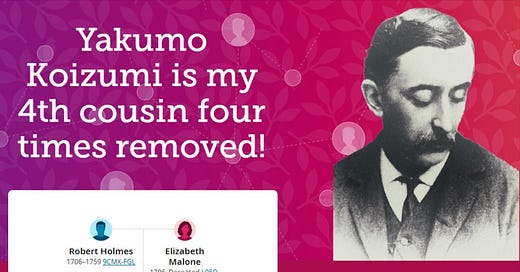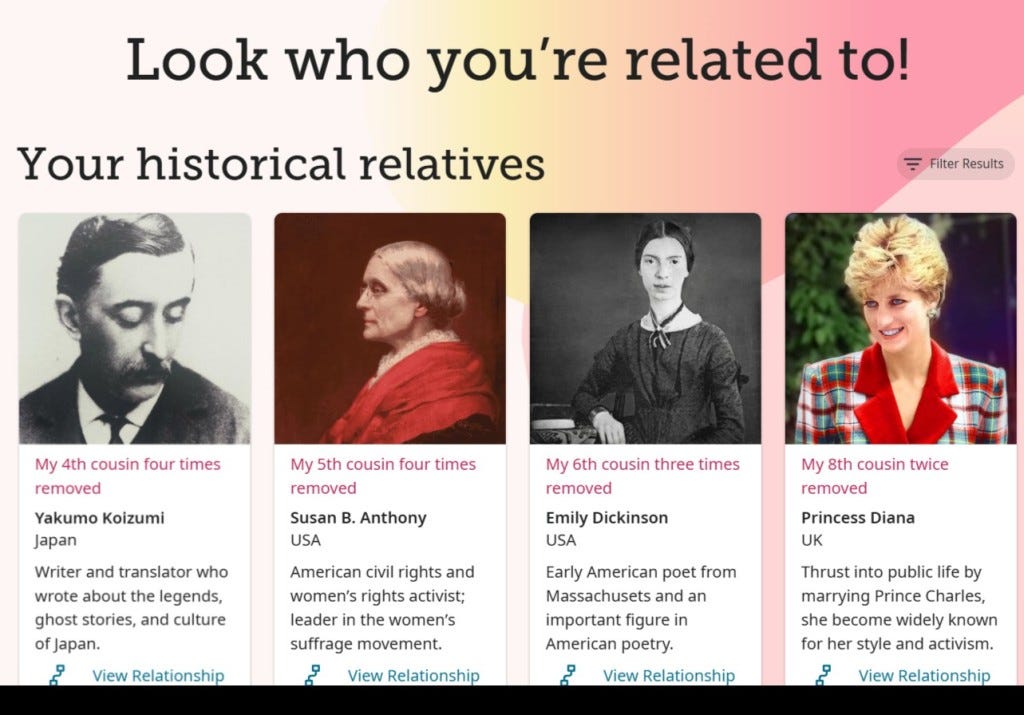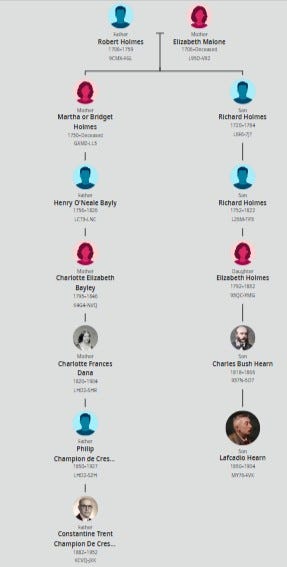RootsTech, if you haven’t heard of it, is a family history and technology conference and trade show held each year in Salt Lake City, Utah. It is organized by FamilySearch, part of the Family History Department of the Church of Jesus Christ of Latter-day Saints. In 2021 in response to the COVID-19 pandemic, RootsTech became a free virtual gathering online. With the pandemic over, the conference has resumed its physical format, though it still offers online sessions.
One of RootsTech’s attractions is a linking service connecting attendees who might be related. The linking app can also search for your famous relatives, ‘famous’ of course, pretty loosely defined.
I gave this a go. My ‘closest famous relative’, it said, was Yakumo Koizumi (1850–1904), one of my fourth cousins four times removed.
This puzzled me. I had never heard of the chap, and anyway, so far as I know, none of my relatives are Japanese, famous or not.
The trick was that Yakumo Koizumi wasn’t really Japanese at all. His surname at birth was Hearn, and he was Irish-Greek.
Patrick Lafcadio Hearn was born in 1850 on the Greek Ionian island of Lefkada to Charles Bush Hearn, an Irish medical officer in the British Army stationed there, and Rosa Hearn nee Cassimati, a native of the Greek island of Kythira. He was baptized Patrikios Lefcadios Hearn, the middle name given to him in honour of the island on which he was born.
I am connected to Lafacadio Hearn through my Irish Holmes and Bayley forebears.
Around 1850 Hearn’s father Charles was promoted to Staff Surgeon Second Class and reassigned from Lefkada to the British West Indies. Rosa and the baby went to Dublin to stay with Charles Hearn’s family.
She did not get on with them, nor they with her. They couldn’t understand each other’s language, and with the Hearns Protestant and Rosa Greek Orthodox, they disagreed over religion. Rosa returned to Greece and the baby—Lafcadio—was left in Ireland in the care of a great aunt, Sarah Brenane. By this time Charles Hearn was serving in the Crimea. The marriage of Charles and Rosa was annulled and custody of Lafcadio and his younger brother was passed to Charles. In 1857 Charles appointed Sarah Brenane Lafcadio’s guardian and with a new, Irish, wife left for India. He died in 1866. Lafcadio never saw his father again.
Lafcadio was educated at a college in France from 1861 and then from 1863 at a Catholic seminary, St. Cuthbert’s College, Ushaw, in County Durham, England. In 1867 Lafcadio’s guardian, Sarah Brenane, became bankrupt and his formal education ceased. He was sent to London to live with one of Brenane’s former maids. She and her husband had no time or money for Hearn, who wandered the streets in an aimless, rootless existence. (He spent some time, however, visiting the British Museum and public libraries, or so he says.)
In 1869 Lafcadio, then nineteen years old, was handed a one-way ticket to New York and given the address of some relatives in Cincinnati. The relatives, he found, were not interested in him and Lafcadio was forced to survive on odd jobs. He wrote of this period:
I was dropped moneyless on the pavement of an American city to begin life.
Lafcadio turned out to have a talent for journalism. He became a writer for the Cincinnati Daily Enquirer, and gained a reputation as the paper’s best sensational journalist, particularly for his lurid accounts of local murders. By 1883 he was writing for Harper’s Weekly, which in 1887 sent him to the West Indies to become its correspondent there.
In 1890, Lafcadio crossed the Pacific to Japan with another commission as a newspaper correspondent. This did not last but he established a home there and found in Japan great inspiration for his writing. He worked as a teacher, and married and had four children. In 1896 he became a Japanese citizen, assuming the legal name Koizumi Yakumo: Koizumi was his wife’s surname and Yakumo he translated as “the Place of the Issuing of Clouds”.
He died in Tokyo in 1904 aged 54.
Lafcadio Hearn became well-known as a writer on Japan, and he is also remembered for his writings about New Orleans and Louisiana, and the West Indies.
I suppose I should read some of his stuff. I’ll start in a small way.
All good work is done the way ants do things: Little by little.
Lafcadio Hearn said that.
Related post and further reading
Relatives at RootsTech (2022)
More relatives at RootsTech (2022)
There is a museum in Matsue, Japan, and a memorial garden in Tramore, County Waterford, Ireland in honour of Lafcadio Hearn. There are also museums dedicated to Hearn in Yaizu, Shizuoka, Japan, and the Lafcadio Hearn Historical Center in Lefkada, Greece.
Lafcadio Hearn. (n.d.). 小泉八雲記念館 | Lafcadio Hearn Memorial Museum. https://www.hearn-museum-matsue.jp/english.html
Lafcadio Hearn. (2020, June 18). Lafcadio Hearn Japanese Gardens. https://www.lafcadiohearngardens.com/lafcadio-hearn/
Wikipedia:
FamilySearch and Wikitree:
FamilySearch: Patrick Lafcadio Hearn (1850-1904) ID MY76-FVK
Wikitree: Patrick Hearn (1850-1904)






What an incredible and fun family story to have! And a great story of resilience that’s been passed down.
This was a great find for you Anne, and he has an interesting story. I haven't had time to check my many Relatives at RootsTech yet, but I has saved the contacts. RootsTech also told me I was related to Princess Diana. I took it with a a grain of salt until I stopped and thought about it. My Waters family farm was a piece of land on the boundary with the Earl Spencer's farm, and once belonged to them. So I suppose it's possible.